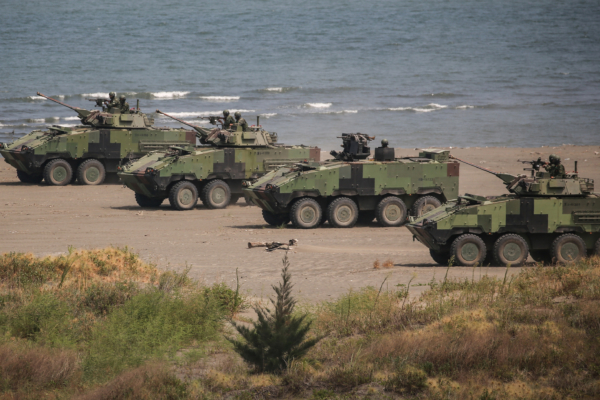Experts in the military community have continuously called for an increase in Taiwan’s defense spending. Scholar David Sacks stated on the 9th that it has been nearly 20 years since former President Chen Shui-bian promised to increase defense spending to 3% of GDP, but Taiwan has yet to reach this goal. The current level of defense spending falls short compared to countries facing similar existential threats, highlighting the need for a swift increase to 5% to show a serious response to the threat posed by the Chinese Communist Party.
President of the Republic of China (Taiwan) Lai Ching-te pointed out on the 6th that the overall defense budget, including funds and special budgets, has reached a new high of NT$647 billion (approximately US$20.92 billion) in strengthening national defense. Researcher David Sacks of the American think tank, The Council on Foreign Relations, stated that while President Lai’s announcement of increased defense budget signifies Taiwan’s commitment to its own security, it fails to convey a sense of urgency.
Sacks noted that Taiwan’s military capabilities will continue to lag behind the People’s Liberation Army, leading to a weakening deterrence in the Taiwan Strait. With increasing pressure from China, Taiwan needs to ramp up defense spending quickly to demonstrate a serious approach to the CCP’s threat, making the Chinese leadership uncertain about the success of any blockade or invasion of Taiwan.
He also acknowledged Taiwan’s efforts to enhance combat capabilities, including former President Tsai Ing-wen’s consecutive increases in defense budgets and President Lai’s proposed budget, which now accounts for about 2.5% of the GDP, exceeding the standard set by NATO member countries.
In addition to increasing defense spending, former President Tsai Ing-wen extended compulsory military service, prioritized the development of asymmetric weapons, successfully developed domestically-made submarines, and advanced reserve military force reform.
Sacks pointed out that while progress has been made, criticism remains regarding Tsai Ing-wen’s failure to reform the conservative culture within the Ministry of National Defense. The MoD is known for its conservatism, particularly in its attachment to traditional large weapons platforms like fighter jets and large surface warships, while being skeptical of adopting an asymmetric defense strategy. Interestingly, all defense ministers during Tsai Ing-wen’s tenure were retired generals and did not prioritize innovative thinking.
There are indications that President Lai Ching-te recognizes the need for substantial reform within the MoD to implement urgently required changes promptly. He appointed Gu Li-hsiung, who previously served as Secretary-General of the National Security Council under Tsai Ing-wen, as the head of the Ministry of National Defense.
Gu Li-hsiung, now the third civilian Minister of National Defense in Taiwan, brings experience from the National Security Council, understanding Taiwan’s complex security situation, U.S.-Taiwan relations, and how Taiwan’s defense is perceived by domestic and foreign observers.
Gu Li-hsiung has already taken several steps to indicate his intent to review MoD operations, change its culture, promote innovation, and may introduce more ambitious policies in the future.
While most foreign observers focus on the percentage of defense spending relative to GDP as a critical indicator of Taiwan’s commitment to its security, Sacks emphasized that the 3% promised by former President Chen Shui-bian nearly 20 years ago should be seen as a minimum standard rather than a ceiling.
Compared to other countries facing similar existential threats, Taiwan’s defense spending appears inadequate. For instance, Israel allocated 4.5% of its GDP to military expenditure in 2022. During the Cold War, the U.S. typically allocated 5% to 10% of its GDP to defense.
In contrast, China announced its defense budget will reach 7.2% in 2025, amounting to US$220 billion (approximately NT$7.2 trillion).
Sacks stressed that Taiwan’s aim should not be merely to increase defense spending but to address urgent needs by investing more resources — providing greater economic incentives to attract people to join the military is one example.
As the PLA conducts more military activities in Taiwan’s surrounding sea and airspace, with the MoD deploying warships in response, the costs for fuel and maintenance will continue to rise. Taiwan urgently needs to develop and produce unmanned aerial vehicles and other unmanned systems, and stockpile ammunition as part of an asymmetric warfare strategy.
To capitalize on the substantial upfront investment in domestically-made submarines, Taiwan needs to spend billions of dollars to produce more hulls. This is just one area where increasing defense spending could truly make a difference.
While Taiwan can determine how to allocate its defense budget, leaders and citizens should understand that these decisions will impact the level of support from the U.S. and other countries.
If the U.S. perceives that Taiwan has made every effort to prepare for the worst-case scenario and will persist in resisting deterrence failures, it is more likely to provide assistance. Therefore, Taiwan’s leaders should embrace a new defense expenditure target of 5% of GDP.
(from Central News Agency, article edited for brevity)

